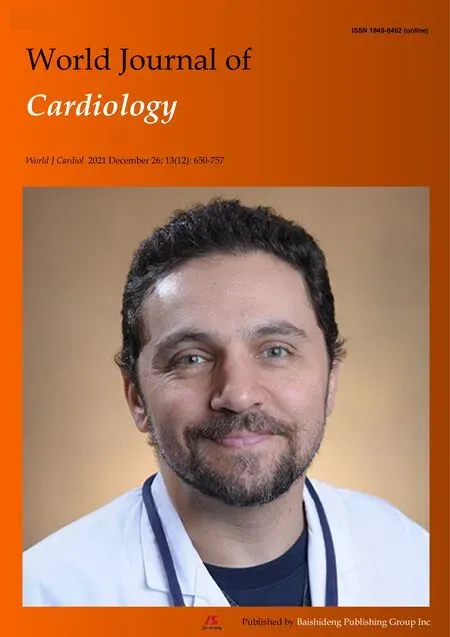Improving the heart team:An interdisciplinary team and integrated practice unit
Elinthon Tavares Veronese,Pablo Maria Alberto Pomerantzeff,Fábio Biscegli Jatene
Elinthon Tavares Veronese,Pablo Maria Alberto Pomerantzeff,Fábio Biscegli Jatene,Department of Cardiovascular Surgery,Heart Institute-University of São Paulo Medical School,São Paulo 05403-900,SP,Brazil
Abstract Heart Team emerged as an important tool in the cardiovascular care,improving the efficiency of decision-making process.In addition to the benefits in patient care,it symbolizes a new culture and mindset.However,beyond the clinical condition,in low/middle-income countries other concerns arise regarding patient's background and these demands are,usually,as challenging as the medical treatment.New models have been proposed face these demands and to assure a holistic care by Integrated Practice Units.Optimization and reorganization of already existing resources and promotion of interdisciplinary and holistic care may be an effective manner to improve outcomes despite socioeconomic barriers.
Key Words:Heart team;Interdisciplinary;Integrated practice units;Cardiovascular;Perioperative;Surgery
INTRODUCTION
Heart Team(Table 1) emerged as an important tool in the cardiovascular care,improving the efficiency of decision-making process[1,2].This multidisciplinary teambased approach has been used for decades in fields as oncology[3] and organ transplantation[4,5] to deliver the best patient care.Although is not a new concept,the termHeart Teamwas incorporated in the cardiovascular care since the publication of SINTAX Trial[6] and,more recently,the PARTNER Trial[7].Both trials used a collaborative team-based approach to decide the better strategy to the myocardial revascularization (surgical or percutaneous) or valvular replacement (surgical or transcatheter),respectively.

Table 1 Members of the interdisciplinary heart team responsible to solve patient's demands before they are referred to waiting surgery list
Using the theory of Venn diagrams[8],this expertise’s overlap among different specialties may improve the challenging decision-making process.In addition to the benefits in patient care,theHeart Teamalso promotes continue education[1,9] through the share-of-knowledge and the built of respect,trust and lasting professional relationship between its members.Besides,the interdisciplinary rounds[10,11] and the incorporation of new devices[12] has been currently used in intensive care medicine[13],reducing miscommunication and improving the comprehension of goals by all team members and patient/family satisfaction[14].
More than a medical multi-specialty interaction,it symbolizes a new culture and mindset,and it has been adopted in many cardiology fields as cardio-obstetrics[15-17],heart failure[18],valvular disease[19-21] and coronary artery revascularization[3].Furthermore,recently published professional societies guidelines for valvular[22-24]and coronary diseases[25] includes theHeart Teamas pivotal to both clinical and interventional therapeutic strategies,especially in complex or high-risk patients.
Beyond the clinical condition,in low/middle-income countries other concerns arise regarding patient's background and these demands are,usually,as challenging as the medical treatment[26].Notedly on valvular disease,the socioeconomic circumstances are crucial.Low scholarity,malnutrition,limited access to the primary care,a high prevalence of rheumatic fever,management of anticoagulation and delayed time referral to cardiac surgery are some of these concerns[27].To face these demands,new models have been proposed[28] to assure a holistic care byIntegrated Practice Units[29].
Our institution is the public biggest cardiovascular center in Latin America,and,beyond the traditionalHeart Team,a pioneer interdisciplinary perioperative project coordinated and supported by the Management Executive Direction has been implemented in our Valvular Diseases Unit to optimize resources and improve outcomes.Since 2018,are part of thisInterdisciplinary Heart Teamthe cardiovascular surgeon,clinical cardiologist,anesthetist,nursing,psychologist,nutritionist,physiotherapist,welfare service and pharmacists.Beyond these professional,we count on a management team responsible for the logistics to optimize further necessary exams,team re-evaluation and surgical scheduling.Before referral to surgery,all-team come together to expose and solve each patients' demands.If no concerns are pending,patient is referred to waiting surgery list.
On the procedure eve the entire preoperative routine is checked by clinician,surgeon and nursing.The intraoperative and intensive care unit,patient is under care according to the clinical,safety and handover protocols.In the ward,besides daily assessment,every patient is reviewed by the entireInterdisciplinary Heart Team.Forecast of hospital discharge,referral to backup hospitals and other demands are discussed.At the hospital discharge,nursing and medical team provide guidance to patients and schedule the postoperative return visit consultation.
CONCLUSION
Even with an unfavorable profile (high proportion of rheumatic disease,redo procedures,multivalvular disease and advanced heart failure status) preliminary results demonstrated reduction of waiting for surgery time and lowering mortality rates.As part of an upper-middle income country,optimization and reorganization of already existing resources and promotion of interdisciplinary and holistic care may be an effective manner to improve outcomes despite socioeconomic barriers.There is always a manner to the improvement.
ACKNOWLEDGEMENTS
We would like to express our gratitude to the motivation and dedication of the entire team of professionals committed to the success of this pioneer project.
 World Journal of Cardiology2021年12期
World Journal of Cardiology2021年12期
- World Journal of Cardiology的其它文章
- Chagas heart disease:An overview of diagnosis,manifestations,treatment,and care
- Cardiovascular benefits from SGLT2 inhibition in type 2 diabetes mellitus patients is not impaired with phosphate flux related to pharmacotherapy
- Dabigatran in cardiovascular disease management:A comprehensive review
- Pulmonary artery catheterization in acute myocardial infarction complicated by cardiogenic shock:A review of contemporary literature
- Prognostic value of left atrial size in hypertensive African Americans undergoing stress echocardiography
- Highly sensitive troponin I assay in the diagnosis of coronary artery disease in patients with suspected stable angina
